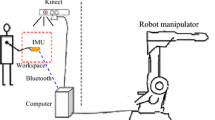Abstract
This paper presents a remote manipulation method for mobile manipulator through operator’s gesture. In particular, a track mobile robot is equipped with a 4-DOF robot arm to grasp objects. Operator uses one hand to control both the motion of mobile robot and the posture of robot arm via scheme of gesture polysemy method which is put forward in this paper. A sensor called leap motion (LM), which can obtain the position and posture data of hand, is employed in this system. Two filters were employed to estimate the position and posture of human hand so as to reduce the inherent noise of the sensor. Kalman filter was used to estimate the position, and particle filter was used to estimate the orientation. The advantage of the proposed method is that it is feasible to control a mobile manipulator through just one hand using a LM sensor. The effectiveness of the proposed human–robot interface was verified in laboratory with a series of experiments. And the results indicate that the proposed human–robot interface is able to track the movements of operator’s hand with high accuracy. It is found that the system can be employed by a non-professional operator for robot teleoperation.













Similar content being viewed by others
References
Maria M, Cristina S, Anselmo F, Ramón C (2014) Real time control of the ASBGo walker through a physical human–robot interface. Measurement 48(2):77–86
João S, Alberto V, Rodrigo V (2015) A multi-purpose rescue vehicle and a human–robot interface architecture for remote assistance in ITER. Fus Eng Des 98–99:1656–1659
Ana CP, Maria M, Miguel AS (2014) Signage system for the navigation of autonomous robots in indoor environments. IEEE Trans Ind Inform 10(1):680–688
Guanglong D, Ping Z (2014) Online serial manipulator calibration based on multisensory process via extended Kalman and Particle filters. IEEE Trans Ind Electron 61(12):6852–6859
Jingying C, Dan C, Xiaoli L, Kun Z (2014) Towards improving social communication skills with multimodal sensory information. IEEE Trans Ind Inform 10(1):323–330
Jian H, Weiguang H, Wenxia X, Samer M, Yacine A (2015) Control of upper-limb power-assist exoskeleton using a human–robot interface based on motion intention recognition. IEEE Trans Autom Sci Eng 12(4):1257–1270
Petr M, Michal R (2014) Speech recognition via STT API for autonomous mobile robot. In: International conference on mechatronics-mechatronika IEEE, pp 594–599
Björn B et al (2014) Active in-hand object recognition on a humanoid robot. IEEE Trans Robot 30(5):1260–1269
Cuong T, Mohan Manubhai T (2012) 3-D posture and gesture recognition for interactivity in smart spaces. IEEE Trans Ind Inform 8(1):178–187
Mohammad K, Wen-Fang X, Abolfazl M (2014) Augmented image-based visual servoing of a manipulator using acceleration command. IEEE Trans Ind Electron 61(10):5444–5452
Guanglong D, Ping Z (2014) Markerless human–robot interface for dual robot manipulators using kinect sensor. Robot Comput Integr Manuf 30(2):150–159
Takahiro N et al (2013) Recognition of grasping motion based on modal space haptic information using DP pattern-matching algorithm. IEEE Trans Ind Inform 9(4):2043–2051
Eshed O, Mohan Manubhai T (2014) Hand gesture recognition in real time for automotive interfaces: a multimodal vision-based approach and evaluations. IEEE Trans Intell Transport Syst 15(6):2368–2377
Guanglong D et al (2014) Human-manipulator interface based on multisensory process via Kalman filters. IEEE Trans Ind Electron 61(10):5411–5418
Ping Z, Xin L, Guanglong D, Bin L, Xueqian W (2015) A markerless human-manipulators interface using multi-sensors. Ind Robot Int J 42(6):544–553
Marion P et al (2017) Director: a user interface designed for robot operation with shared autonomy. J Field Robot 34(2):262–280
Leap Motion. https://www.leapmotion.com. Aug 2014
Frank W et al (2013) Analysis of the accuracy and robustness of the leap motion controller. Sensors 2013(13):6380–6393
Ho Kim M, Suk L, Kyung Chang L (2010) Kalman predictive redundancy system for fault tolerance of safety-critical systems. IEEE Trans Ind Inform 6(1):46–53
Seong-Hoon W, Wael William M, Farid G (2009) A fastening tool trackingsystem using an IMU and a position sensor with Kalman filters and a fuzzy expert system. IEEE Trans Ind Electron 56(5):1782–1792
Yun X, Bachmann ER, McGhee RB (2008) A simplified quaternion-based algorithm for orientation estimation from earth gravity and magnetic field measurements. IEEE Trans Instrum Meas 57(3):638–650
Guanglong D, Ping Z (2014) Human-manipulator interface using hybrid sensors with kalman filters and adaptive multi-space transformation. Measurement 55:413–422
Seong-Hoon Peter W, Wael William M, Farid G (2010) A Kalman/Particle filter-based position and orientation estimation method using a position sensor/inertial measurement unit hybrid system. IEEE Trans Ind Electron 57(5):1787–1798
Seong-Hoon Peter W, Wael William M, Farid GM (2011) Fastening tool tracking system using a Kalman filter and particle filter combination. Meas Sci Technol 22(12):1–12
Antonelli G, Chiaverini S, Fusco G (2003) A new on-line algorithm for inverse kinematics of robot manipulators ensuring path tracking capability under joint limits. IEEE Trans Robot Autom 19(1):162–167
Jinling W (2000) Stochastic modeling for real-time kinematic GPS/GLONASS position. Navigation 46(4):297–305
Weidong D, Jinling W, Chris R (2007) Improving adaptive kalman estimation in GPS/INS integration. J Navig 60(3):517–529
Glas DF, Kanda T, Ishiguro H, Hagita N (2012) Teleoperation of multiple social robots. IEEE Trans Syst Man Cybern A Syst Hum 42(3):530–544
Acknowledgements
The project was funded by “Guangdong Natural Science Funds for Distinguished Young Scholar (2017A030306015),” “Pearl River S&T Nova Program of Guangzhou (201710010059),” “Guangdong special projects (2016TQ03X824),” “the Fundamental Research Funds for the Central Universities (No: 2017JQ009),” “National Natural Science Foundation of China (Nos: 61403145, 61602182).”
Author information
Authors and Affiliations
Corresponding author
Additional information
Publisher's Note
Springer Nature remains neutral with regard to jurisdictional claims in published maps and institutional affiliations.
Rights and permissions
About this article
Cite this article
Chen, M., Liu, C. & Du, G. A human–robot interface for mobile manipulator. Intel Serv Robotics 11, 269–278 (2018). https://doi.org/10.1007/s11370-018-0251-3
Received:
Accepted:
Published:
Issue Date:
DOI: https://doi.org/10.1007/s11370-018-0251-3




